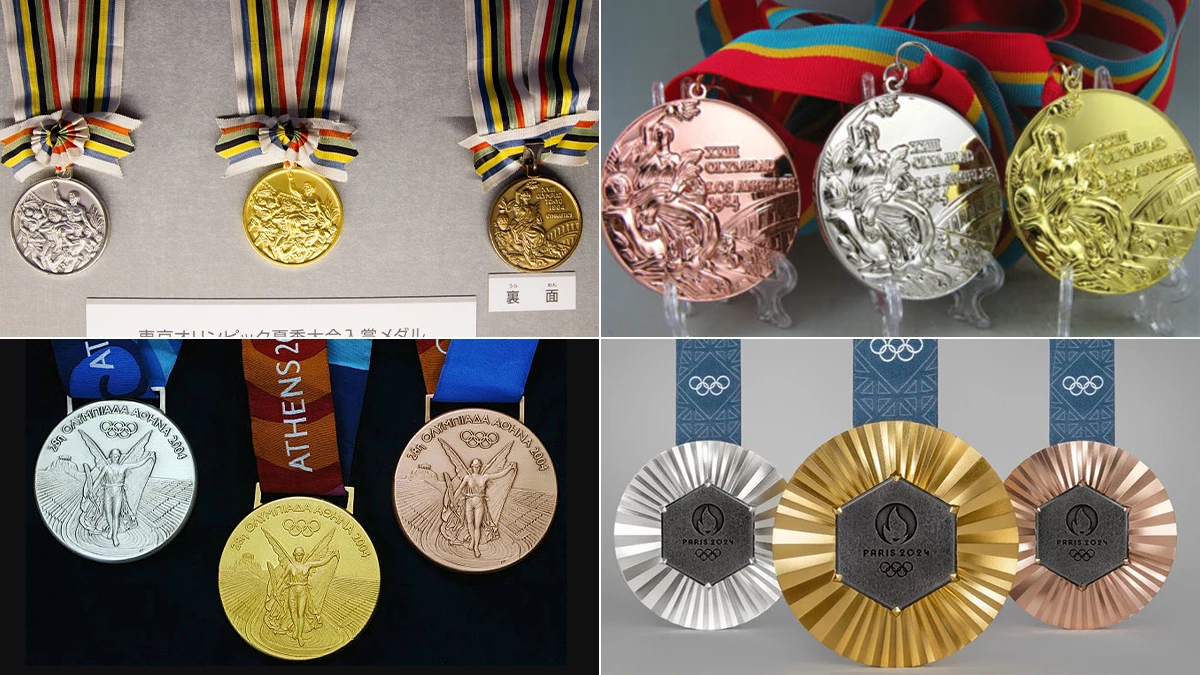“He who is not courageous enough to take risks will accomplish nothing in life”- Muhammad Ali, American Boxer and 1960 Olympics gold medalist.
In the quiet moments when the world sleeps, an athlete dreams of gold. Years and years of hard work, sacrifice, blood, sweat, and tears come down to a single shining object- the Olympic medal. As the medal of victory is draped around their neck, each one of us is reminded of its true beauty which lies in the immense struggle and sacrifice leading to this glorious moment.
What if we told you that beneath the shining surface of these Olympic medals lies a story as rich and beautiful as the medals themselves. These medals are more than symbols of victory; they are masterpieces of history, fine craftsmanship and long standing traditions. Come, let’s dive into the enchanting world of Olympic medals and find out the mesmerizing tales of these iconic symbols of human excellence to stay inspired.
A Glorious History: From Ancient Origins to Modern Marvels
You will be surprised just like us to know a fact from the past. The winners of the original Olympic Games in 776 BCE were awarded olive wreaths, also known as kotinos, instead of a medal. It was in the year 1896, the inaugural of the modern Olympic Games in Athens when the tradition of giving medals as rewards came to light.
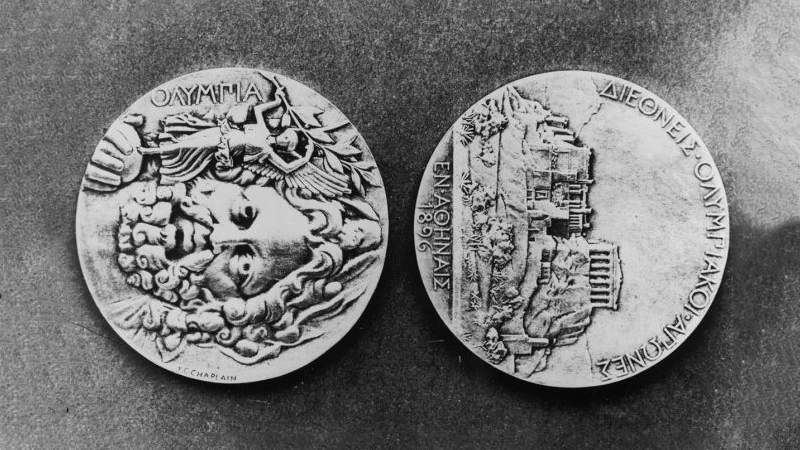
Initially, the winners were rewarded with a silver medal while the second finishers took home a bronze medal. Fast forward to the year 1904, the St. Louis Olympics, that’s when the concept of giving a gold medal to the winner was born. The new format was established where the athlete who comes first would be rewarded with a gold medal, the second one with silver, and the athlete who comes third would be draped in a bronze medal.
Craftsmanship and Composition
If you are a fan of sports and have been watching the Olympics, you might have assumed that the Olympic medals, as the name suggests, are made up of gold, silver, and bronze but here is the shocking information. The gold medals are not entirely composed of 100% gold, it’s just plated with gold. But the case with silver and bronze medals is different. True to their names, they are made entirely of silver and bronze.
The host city of the Olympics is responsible for creating the medals. Each city that hosts the Olympics adds a unique and personal touch to these precious medals. Of course, they have to follow the guidelines ensuring its authenticity and quality but that doesn’t stop them from showing their creativity. Let’s learn a little bit about each type of medal composition.
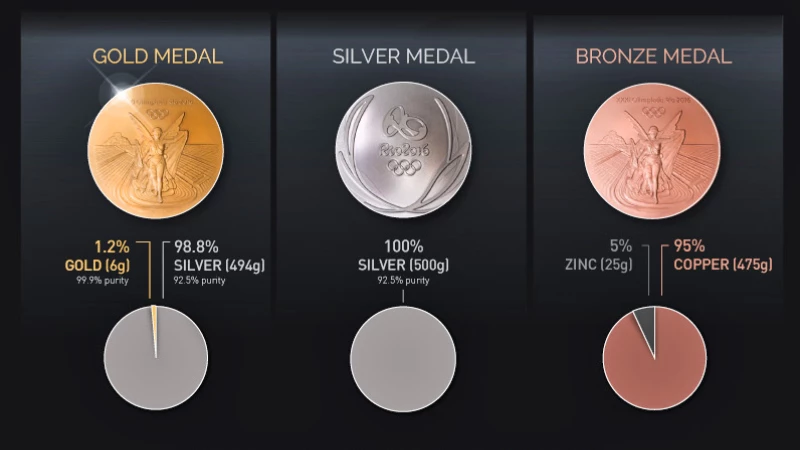
Gold Olympic Medals
“Gold medals aren’t really made of gold. They’re made of sweat, determination, and hard-to-find alloy called guts”- Dan Gable, American wrestling champion and Olympic gold medalist.
Gold doesn’t define the value of the Olympic medal, the athlete who wins it does. So, the story of the Olympic gold medal goes like this. The last gold medal that was actually made up of pure gold was during the 1912 Olympics in Stockholm, Sweden. Since then, it primarily consists of silver with a thin layer of pure gold plating for the appearance.
Compositions and designs may vary between different Olympics but rules are rules, right? The International Olympic Committee mandates that there should be 6 grams of pure gold in each medal. Given that the weight of a medal should be in the range of 450g to 500g, the percentage of gold turns out to be roughly 1.2%.
Silver Olympic Medals
Silver Olympic medals, often seen as the gateway to the highest spot on the podium represent each athlete’s countless hours of hard work and dedication. They truly tell the story, in the most beautiful way, of an athlete who didn’t give up.
Contrary to the gold Olympic medals, silver medals live up to their names. They are actually made up of mostly silver with a purity of at least 92.5% as set by The International Olympic Committee. Ring a bell? 92.5% or 925 silver is also the benchmark for silver jewelry.
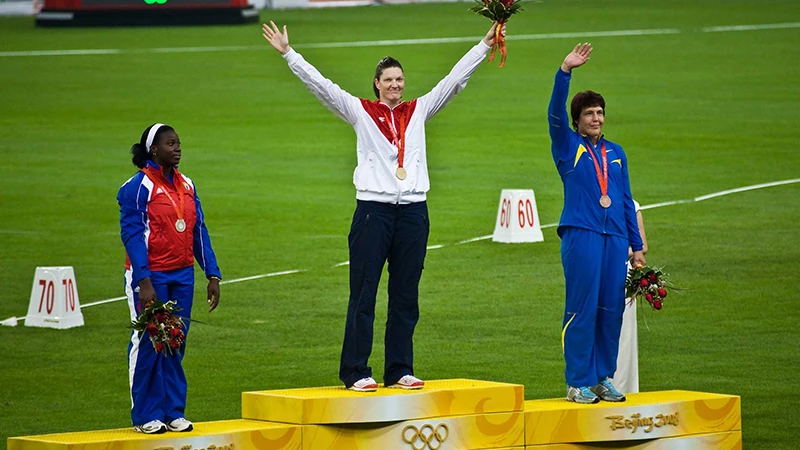
Each country that hosts the Olympics has to maintain the highest standards of authenticity. The weight of the silver medals may vary from one Olympics to another but it normally ranges between 500 to 800 grams, offering the perfect balance to its shape.
Bronze Olympic Medals
Bronze medals are made up of very small amounts of silver. They mostly include copper, zinc, and tin which result in a durable finish. Bronze medals are symbols of resilience and perseverance. They may represent third place but they also represent the strength of an athlete who fought, but a few others simply did a little better.
As with the other medals, bronze medals too may vary from one Olympics to another in terms of weight. But as set by The International Olympics Committee, each medal weighs between 1 to 1.8 pounds.
The Evolution of Medal Design
Olympic medals are not just symbols of victory but they are a treasure of deep cultural and symbolic meanings. They represent an athlete’s achievement, years of sacrifice, and the journey of overcoming obstacles. Each host city shows its unique beauty through their creativity and fine craftsmanship in the designs of the medals. Let’s find out how the medals looked over the years.
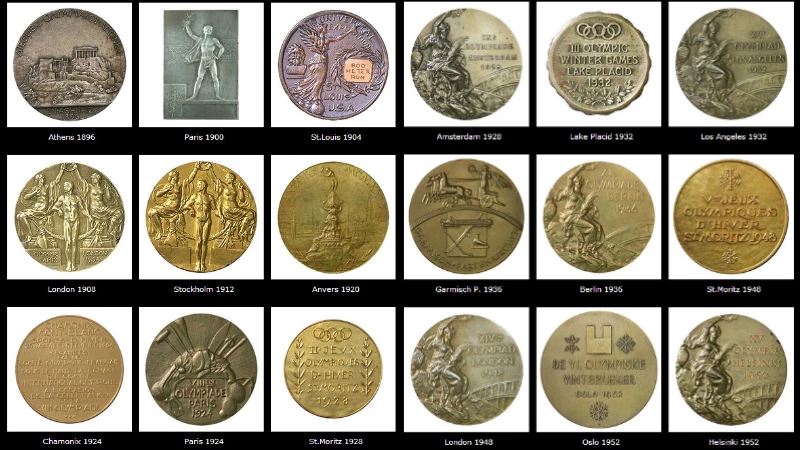
Olympics 2012, London
Olympic medals during the 2012 Olympics hosted by London were a treat for the eyes. They featured the famous River Thames and the iconic London skyline.
Olympics 2016, Rio de Janeiro
Rio de Janeiro, on the other hand, used a sustainable approach in producing Olympic medals for the 2016 Olympics. They used recycled materials from leftover mirrors and X-ray plates. These symbols of victory featured images of laurel leaves, paying homage to the ancient Greek traditions.
Olympics 2020, Tokyo
While we are on the topic of emphasizing sustainability and environmental responsibility, how can we not mention the Olympics hosted by Tokyo in 2020 and their huge step towards promoting eco-friendly measures. Tokyo broke all records and made a global achievement of collecting approximately 80,000 tons of used consumer electronics over the period of two years. These included 6.2 million used mobile phones, laptops, and cameras.
The medals produced from these recyclable materials reflected beautiful patterns of light symbolizing the positive energy of athletes and their well-wishers perfectly supporting the Olympics theme of diversity and friendship.
Olympics 2024, Paris
As we look forward to the return of the Olympics to Paris in 2024, one of the most exciting aspects is the design of the Olympic medals. To celebrate the 100 years since Paris has hosted the Olympics, each medal will contain a piece of actual iron from the iconic Eiffel Tower. Yes, you read it right.
Along with that, each medal will feature three main things. First is a hexagon made of the original Eiffel Tower iron, second are the fine radiance lines that project outwards from the hexagon, and lastly, six metal appendages. Each one is used to fix the hexagon in its place. For the Olympics 2024, Paris has chosen the distinctive “Clous de Paris” hobnail shape that basically reminds us of the small pyramid shape of the iconic Eiffel Tower.

Icons of Victory
Have you ever wondered why an athlete bites the Olympic medal when they win it? You will be surprised to know that there is no long standing tradition behind it. It is mostly requested by the photographers as it is a great pose for the pictures.
However, it has now become a new and exciting trend followed by every athlete. Winning a medal in the Olympics is still a dream for many. However, reaching that stage is in itself a moment of glory and personal achievement.
Olympic medals are not just any rewards; they are the greatest symbol of human excellence and every nation’s pride. Over the years, some athletes have risen to extraordinary heights with their exceptional performances and won not one, not two, but an unbelievable number of medals. It will be unfair if we don’t talk about their beautiful triumphs.
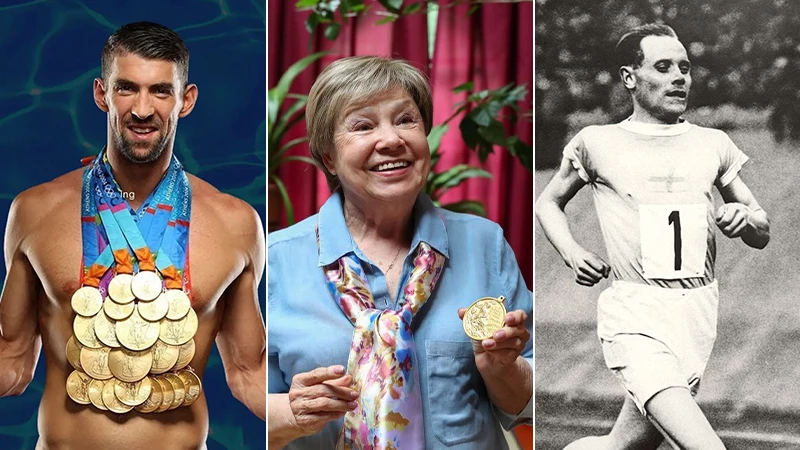
Michael Phelps: The Great American Swimmer
“You can’t put a limit on anything. The more you dream, the farther you get”- Michael Phelps.
The undefeated king of the Olympic pool, Michael is one of the most decorated Olympians of all time with the highest number of 28 Olympic medals.
Wait, it doesn’t end here. The American swimmer is also a leader in winning the highest number of Olympic gold medals. Can you guess the number? Let us tell you. It’s 23. He truly is the champion with his dominance in swimming and the medals are the witness of his indomitable spirit.
Larisa Latynina: World Class Russian Gymnast
After the legendary swimming champion Michael Phelps comes another champion. She is from the world of gymnastics, Larisa Latynina. The world class Russian gymnast won a total of 14 Olympic medals including 9 gold medals, 5 silver, and 4 bronze medals. She won all these medals over 3 different Olympics that took place between 1956 and 1964. Her incredible performance year after year made her a legend in her arena.
Paavo Nurmi: The Finnish Running Champion
Every Olympic medal comes with a story, a journey of hard work and extraordinary achievements. Paavo Nurmi, a middle-distance and long-distance runner is also known as the “Flying Finn” or “Phantom Finn” of the Olympics. The Finnish legend has won nine gold and silver medals between 1920 and 1928. These medals are more than just rewards; they are symbols of his unwavering commitment.
Paris Olympics 2024: A Glimpse into the Future
Olympics 2024 is about to begin on 26 July 2024 and will go on till 11 August 2024. The Paris Olympics 2024, the greatest event on the Earth, is ready to be a grand spectacle of sport and culture. Here is all that you can expect.

What to Expect
As we look forward to the Paris Olympics 2024, how can we not mention Simone Biles, the greatest gymnast of all times. She is ready to add another chapter to her thick book of achievements. The champion who is not only famous for her exceptional gymnastic skill but also for her incredible fashion statements and minimalistic jewelry choices is all set to make a comeback in the Olympics 2024.
On the other hand, Noah Lyles also known as the “fastest man in the world” is likely to steal the show with his sense of style and athletic performance. We are really hoping he wins his first Olympic medal in Paris after three straight wins at the World Championships.
Along with these champions, you might also witness some jaw-dropping performances by Carissa Moore, PV Sindhu, Jimmer Fredette, and other great athletes.
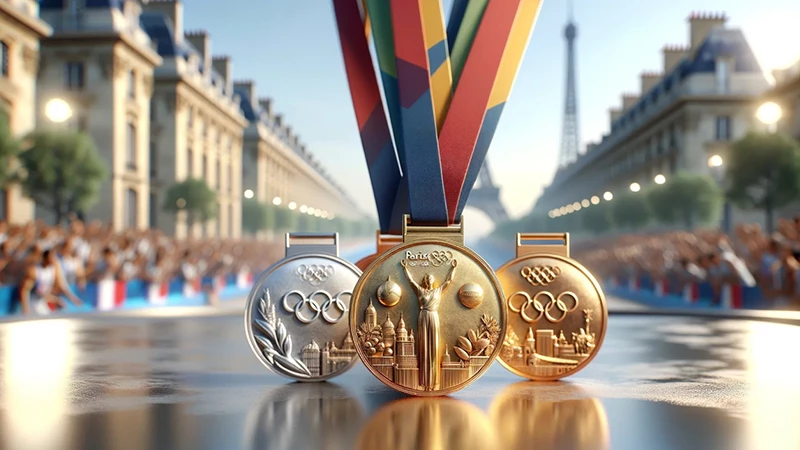
A Celebration of Excellence
Whether gold, silver, or bronze, each medal is a tangible symbol of an athlete’s legacy and their hard fought battles. The creation of medals is a huge process that involves fine craftsmanship, state-of-the-art technology, and traditional inspirations.
We now see that nations are focusing more on eco-friendliness and therefore create medals using sustainable and recyclable materials. So, don’t you think we should also embrace sustainability in our everyday lifestyle?
Explore GemsNY’s sustainable and stylish jewelry pieces to step up your fashion game and do your bit for the environment. That’s a win-win, right? Elevate your fashion with beautiful pendants, rings, and bracelets and create cherishing moments just like our Olympic athletes.
